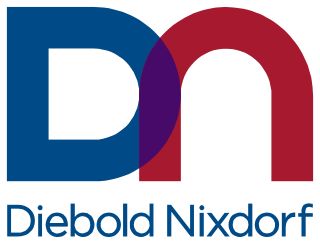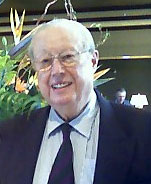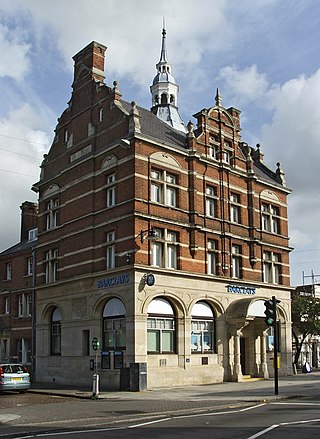
An automated teller machine (ATM) is an electronic telecommunications device that enables customers of financial institutions to perform financial transactions, such as cash withdrawals, deposits, funds transfers, balance inquiries or account information inquiries, at any time and without the need for direct interaction with bank staff.

Diebold Nixdorf is an American multinational financial and retail technology company that specializes in the sale, manufacture, installation and service of self-service transaction systems, point-of-sale terminals, physical security products, and software and related services for global financial, retail, and commercial markets. Currently Diebold Nixdorf is headquartered in the Akron-Canton area with a presence in around 130 countries, and the company employs approximately 23,000 people. Founded in 1859 in Cincinnati, Ohio as the Diebold Bahmann Safe Company, the company eventually changed its name to Diebold Safe & Lock Company. In 1921, Diebold Safe & Lock Company sold the world's largest commercial bank vault to Detroit National Bank. Diebold has since branched into diverse markets, and is currently the largest provider of ATMs in the United States. Diebold Nixdorf was founded when Diebold Inc. acquired Germany's Wincor Nixdorf in 2016. It is estimated that Wincor Nixdorf controls about 35 percent of the global ATM market.

Bank of Ceylon is a state-owned, major commercial bank in Sri Lanka. Its head office is located in an iconic cylindrical building in Colombo.

John Adrian Shepherd-BarronOBE was an India-born British inventor, who led the team that installed the first cash machine, sometimes referred to as the automated teller machine or ATM.
A Talking ATM is a type of automated teller machine (ATM) that provides audible instructions so that persons who cannot read an ATM screen can independently use the machine. All audible information is delivered privately through a standard headphone jack on the face of the machine or a separately attached telephone handset. Information is delivered to the customer either through pre-recorded sound files or via text-to-speech speech synthesis.

Payment cards are part of a payment system issued by financial institutions, such as a bank, to a customer that enables its owner to access the funds in the customer's designated bank accounts, or through a credit account and make payments by electronic transfer and access automated teller machines (ATMs). Such cards are known by a variety of names including bank cards, ATM cards, client cards, key cards or cash cards.

An ATM card is a payment card or dedicated payment card issued by a financial institution which enables a customer to access their financial accounts via its and others' automated teller machines (ATMs) and to make approved point of purchase retail transactions ATM cards are not credit cards or debit cards. ATM cards are payment card size and style plastic cards with a magnetic stripe and/or a plastic smart card with a chip that contains a unique card number and some security information such as an expiration date or CVVC (CVV). ATM cards are known by a variety of names such as bank card, MAC, client card, key card or cash card, among others. Other payment cards, such as debit cards and credit cards can also function as ATM cards. Charge and proprietary cards cannot be used as ATM cards. The use of a credit card to withdraw cash at an ATM is treated differently to a point of sale transaction, usually attracting interest charges from the date of the cash withdrawal. Interbank networks allow the use of ATM cards at ATMs of private operators and financial institutions other than those of the institution that issued the cards.
ATM usage fees are the fees that many banks and interbank networks charge for the use of their automated teller machines (ATMs). In some cases, these fees are assessed solely for non-members of the bank; in other cases, they apply to all users.
The Global ATM Alliance is a joint venture of several major international banks that allows customers of their banks to use their automated teller machine (ATM) card or debit card at another bank within the alliance with no international ATM access fees. Other fees, such as an international transaction or foreign currency fee, may still apply for some account holders. Participating banks are located around the globe.

A branch, banking center or financial center is a retail location where a bank, credit union, or other financial institution offers a wide array of face-to-face and automated services to its customers.

Dollar Bank is a full-service regional savings bank serving both individuals and business customers, operating more than 90 offices throughout Pennsylvania, Ohio, Maryland, and Virginia. The bank's Pennsylvania headquarters is located in downtown Pittsburgh, Ohio headquarters is located in downtown Cleveland, and Virginia headquarters is located in Hampton Roads.

The Wolseley is a restaurant located at 160 Piccadilly in London, England, next to the Ritz Hotel. Designed by the architect William Curtis Green, the Grade II* listed building was erected by Wolseley Motors in 1921 as their regional offices with a ground floor showroom. The ground floor was occupied by a branch of Barclays Bank between 1927 and 1999. It was a Chinese restaurant for a couple of years then reopened in 2003 as an upscale European restaurant after renovation by British restaurateurs Chris Corbin and Jeremy King.
Tamilnad Mercantile Bank Limited (TMB) is a bank headquartered at Thoothukudi, Tamil Nadu, India. TMB was founded in 1921 as the Nadar Bank, but changed its name to Tamilnad Mercantile Bank in November 1962 to widen its appeal beyond the Nadar community. For the financial year 2018–2019, the bank reported a net profit of ₹ 2585 million. The bank currently has 509 full branches throughout India, 12 Regional offices and two link offices, two central processing centres, one Service Branch, four Currency Chests, 48 eLobby centres, 262 Cash Recycler Machines and 1151 Automated Teller Machines (ATM). The bank has been expanding its footprint all over India.

Sampath Bank PLC is a licensed commercial bank incorporated in Sri Lanka in 1987 with 229 branches and 373 ATMs island-wide. It has won the "Bank of the Year" award by "The Banker" of Financial Times Limited – London, for the second consecutive year and the "National Business Excellence Awards 2010". It has become the third largest private sector bank in Sri Lanka with Rs. 453 billion in deposits as of 30 June 2016.
Clayton & Black were a firm of architects and surveyors from Brighton, part of the English city of Brighton and Hove. In a career spanning the Victorian, Edwardian and interwar eras, they were responsible for designing and constructing an eclectic range of buildings in the growing town of Brighton and its neighbour Hove. Their work encompassed new residential, commercial, industrial and civic buildings, shopping arcades, churches, schools, cinemas and pubs, and alterations to hotels and other buildings. Later reconstituted as Clayton, Black & Daviel, the company designed some churches in the postwar period.

Barclays is a British multinational universal bank, headquartered in London, England. Barclays operates as two divisions, Barclays UK and Barclays International, supported by a service company, Barclays Execution Services.

2 Haymarket is a listed building in Sheffield City Centre in England.

William Gillbee Scott, sometimes William Gilbee Scott, (1857-1930) was an English architect who designed the Gower Street Memorial Chapel, the Salvation Army Citadel in Sheffield, and the London and Provincial Bank in Enfield.

The London and Provincial Bank, originally known as the Provincial Banking Corporation, was established in 1864.

107–109 Bathurst Street, Sydney is a heritage-listed former bank building and now KFC fast food restaurant located at 107–109 Bathurst Street in the Sydney central business district, in the City of Sydney local government area of New South Wales, Australia. The property is privately owned. It was added to the New South Wales State Heritage Register on 2 April 1999.





















